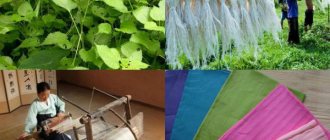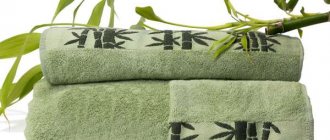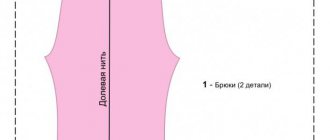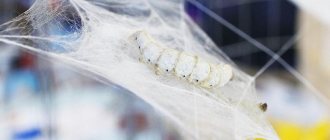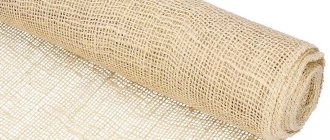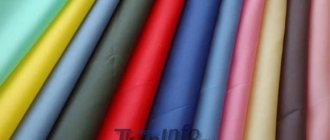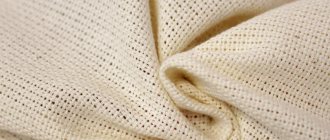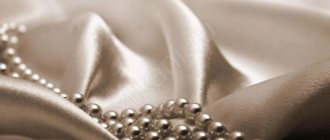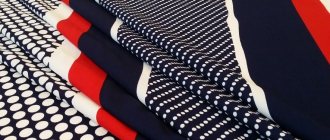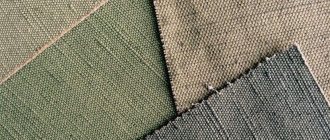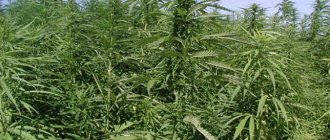Ramie fabric, composition and properties
Recently, there are more and more people wanting to buy clothes made from ramie.
This fabric has won the love of many, especially those who belong to the progressive part of society and strive to improve the environmental situation not only in the world, but also in everyday life. Clothes made from ramie.. For the vast majority of people, the phrase “fabric made from nettles” evokes a feeling of fear rather than positive emotions. And in vain!
We will tell you about such a unique discovery of humanity as ramie - the so-called Asian or Chinese nettle. Although this discovery is no longer a century old, not everyone knows about all the wonderful properties of this plant.
Ramie is a perennial plant used in medicine, paper making, weaving, etc. Cultivated in 2 types: green and white fiber. The length of the plant stems reaches two and a half meters. Traditionally, the crop is harvested up to 6 times a year. Harvesting requires a lot of work, so ramie can easily be considered one of the most noble fibers.
The fibers of this plant have a fairly high strength, which especially attracts designers and technologists. The tensile strength of this fiber can be approximately seven times that of cotton and silk! An important role in this indicator will be played by how carefully they approached growing the plant and obtaining fiber at the time.
The fiber has a natural white color and glossy shine, which is so appreciated by lovers of ramie fabrics. At the same time, unlike silk, which can lose its appearance when exposed to sunlight, nettle fabrics do not lose their shine at all.
Another feature is that the fiber does not rot, is not prone to corrosion and is resistant to insect attacks. This allows you to protect the plant from chemical treatments and obtain the most environmentally friendly raw materials. Moreover, recent studies have shown that planting the ramie plant itself can save the soil from erosion. So the ecological role of this plant takes place in all periods of its existence: from planting to the use of its fibers in fabrics and the manufacture of products from these fabrics.
Speaking of products... Due to its advantages, fabric containing ramie fibers has found its application in home textiles, children's and adult clothing, accessories, bed linen, curtains, tablecloths, tapestries and many others.
Recently, there are more and more people wanting to buy clothes made from ramie. This fabric has won the love of many, especially those who belong to the progressive part of society and strive to improve the environmental situation not only in the world, but also in everyday life. Clothes made from ramie allow the body to “breathe”; the fiber perfectly absorbs moisture and dries quickly, thereby maintaining a slight feeling of coolness. This makes such clothes very comfortable, especially in the warm season. One of the properties of ramie fabric is natural antistatic. In addition, the fabric washes well, can be washed without difficulty and does not lose its appearance after drying. Some even claim that clothes become even brighter after washing.
There is one more useful property that deserves a separate topic. Ramie has antibacterial properties and prevents the proliferation of various unwanted microorganisms and fungi. Thanks to this, ramie is a valuable fabric for the production of children's clothing and bed linen.
The low elasticity coefficient of the fiber is perhaps the only drawback when using it in clothing. But the composition of ramie fabric is often combined with other fibers, resulting in unique fabrics. For example, a wool product will shrink less if it contains ramie fibers. Also, ramie imparts strength to viscose materials, which a priori have low strength. Mixing ramie with other fibers allows you to create durable, wear-resistant, shape-resistant products with interesting color schemes, because ramie is very easy to dye.
Nowadays ramie is used mainly in luxury fabrics, because this natural fiber, which is not obtained in the easiest way, has a lot of useful properties. The main producers of ramie fabrics are: China (occupies most of the market), South Korea, the Philippines, India, Brazil and Thailand. And in Korea, in honor of ramie, they even hold an annual festival, which attracts the best designers specializing in environmentally friendly clothing. There is a fashion show at the festival, and the clothes on the models are made from ramie fabrics. Also, a fair of these wonderful outfits is organized at the festival.
For those who value eco-fabrics, care about their health and comfort, and for those who simply follow the trend, ramie fabrics have already become a pleasant discovery and have taken their strong place in everyday life. Everything you learned about ramie today is not all that can be said about it. From generation to generation, since the time of the Scythians, ramie has been used by humanity and confirms its right to a rightful “place in the sun” among other fabrics!
Irina Zadorozhnaya.
Assortment of ramie fabrics in the catalog of the EcoFabrics store:
ramie fabrics (from nettle)
Ramie fabric Blue-blue sky
Nettle fabric, delicate natural shade
Beautiful red nettle fabric
Ramie fabric, shimmering mint
Chinese nettle Ramie
Chinese ramie has little resemblance to our nettle; it is much taller (1.2 to 2.3 meters). The stems are even and straight, not at all burning, the leaves also do not inspire fear, they are more like mint leaves.
Ramie can only grow with good humidity and fairly warm climate conditions. The plant itself does not require special care, it is unpretentious...
Ramie stems consist of 20% fine, white fibers.
Manufacturers of ramie clothing
- "Zara";
- "Mango";
- "Collins."
The following are made from combined fabrics:
- Blouses;
- Business attire;
- Clothes for pregnant women;
- Children's clothing;
- Shirts;
- Trousers;
- Skirts;
- Dresses.
Mango production
Clothing mixed with natural fiber has a positive effect on the body:
- Normalization of blood pressure;
- Improved blood flow;
- Getting rid of migraines;
- The clothing is recommended for wear by people with allergic reactions.
Care Tips
Ramie fabric, like other types of textiles made from natural fiber, requires special care. It is recommended to wash it gently by hand without bleaching. If there are stubborn stains, it is permissible to use professional dry cleaning. Basic care recommendations look like this.
- Wash by hand or machine, on gentle cycle . Temperature range – 40-60 degrees Celsius. It is recommended to wash ramie clothes separately from other items, using special washing gels.
- Machine or manual spinning, without strong twisting of the products . Creases are difficult to fix. When performing a machine spin, the drum rotation speed should be set to medium.
- Drying is natural. Before hanging, the products are straightened. When drying indoors, it is important to ensure good ventilation. It is also possible outdoors.
- Ironing at a temperature of +150 degrees . First, things are turned inside out. Products can be steamed.
It is not recommended to paint yourself, bleach or expose nettle fabric and products made from it to other aggressive chemicals. Products should be dried and folded in a horizontal position, especially if we are talking about 100% natural ramie fabric. Its fibers are more brittle, and it is quite difficult to smooth out the resulting wrinkles even with a steamer.
The plant is edible
In principle, Boehmeria is an edible plant. Or rather, you can use its roots in cooking - peeled and boiled, they have a quite pleasant, slightly sweet taste. But such a dish can hardly be called a delicacy - the thing is that the root has a very strange, unusual slimy texture, which most people who have tried it do not like, despite its very good taste. And before swallowing the cooked root, you need to chew it for a long time and thoroughly in order to fully experience all the unusualness of its texture. Sometimes in the Asian region, young leaves of Boehmeria are used in making cakes. The leaves are also used as a dye to make the traditional Asian black rice cake.
Ramie leaves are used in folk medicine in Asia to relieve internal fevers, treat urethral infections and wounds; and the roots are used to treat threatened miscarriage, colic during pregnancy, and hemorrhoids. In addition, young leaves are used as food for silkworms.
Advantages of natural nettle washcloths
The advantages of natural nettle bath accessories include environmental friendliness and pleasant sensations when used. The washcloth does not lose its color; with frequent use, the quality of the fiber is not lost.
If you want to have clean, smooth skin and get rid of cellulite, this is the washcloth for you!
